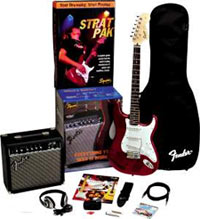There are many myths floating around in the guitar community about amplifiers. Many myths claim that better tone can be achieved by certain “tricks of the trade”. Surprisingly, there are a great number of these myths that even the experts themselves sometimes believe- so it can often be hard to separate amplifier fact from fiction.

Figure 1 – The wealth of amplifier types, models, and effects have created a great deal of myths as to which particular way to go is best.
The most common misconstrued belief in the amplifier market is that twice the wattage means twice the volume. This could not be further from the truth, as it is actually true that ten times the wattage means tice the volume. Essentially this means that that 10 watt amp that comes with cheap guitar bundles is only half as loud as that new 100 watt amp you’ve been looking at with a passion. So what really determines sound? Wattage does have a big part in how loud an amplifier sounds, but so does the class of amplifier, speaker efficiency, and speaker surface area. Higher watt amplifiers can play lower wattage sounds better, because they have more power- but it is very important to test an amplifier out before purchasing it based on wattage levels.
Another interesting belief is that performances require high wattage amplifiers- often over 100 watts or more. This isn’t necessarily true, since a tube amplifier can do around 2-3 times the volume a solid state amplifier can. Basically, solid state amplifiers use transistors for signal gain, while tube amps use “tubes” or “valves”. Aside from sounding much better at higher volumes than solid state amplifiers,tube amplifiers can also usually outperform a 100 watt solid state amplifier with a 30-50 watt tube amplifier. When tone and volume is a big concern, tube amplifiers are the way to go.

Figure 2 – We all have to start somewhere- but keep in mind that the amplifier in most guitar bundles produce poor tone and sound quality. Even still, a 100 watt amp is technically only twice as powerful as most of these small amplifiers.
Hybrid technology isn’t everything that hybrid technology has become to be in today’s society. Hybrid cars, for instance, serve a purpose to save the owner gas money and help the environment. One would likewise think that hybrid amplifiers that incorporate both tube and solid state amplifier technoogy would be the best of both worlds. Sadly, this is far from the truth. These hybrid amplifiers will usually have one tube or valve in the preamp section. This does little to nothing for the final output and tone, although there are some exceptions to the rule. Mainly, these types of amplifiers are used as a marketing ploy- and serve to trick buyers into saving money on a hybrid tube amplifier, rather than spending the extra cash.
When dealing with amplifiers, there are many things to remember when purchasing them. More wattage doesn’t mean better tone, or even that much more volume. Solid state amplifiers generally sound poor at high levels, and usually fall short of tube amplifiers. Lastly, don’t be fooled by hybrid amplifiers- they usually are a marketing ploy. It is important to go out to a local musician’s shop and test out amplifiers before purchasing them- even if it means ordering on the internet afterwards to get a better deal.
Hi nice article – The volume side of things is a common musconception. You sure can’t beat a cranked tube amp.
hey Zac,
Just and FYI, your sidebar gets bumped below the main body of the page on indavidual post pages. Just wanted to give you a heads up…
nice article, definitely true about you don’t need a loud amp for a gig, you can always just mic a little one. I know many guitarists that play sold out 20,000 seat stadiums with a 65 watt amp connected to the PA. However, tube and solid state amps at 100 watts put out 100 watts of sound period at max volume. Tubes DO NOT produce MORE sound than solid state amps, and equal wattage will mean equal max sound. This is a common misconception due on the fact that they “break up” much clearer at higher levels, and sound much better. It has to do with the way the wave drops off (guitar coming through an amp, like any sound is a repeating wave with a shape and frequency).
I use a Line 6 spider stereo 30 and a Line 6 FlexTone 111 which I do my initial tonal and floorboard and amp modelling, for tour setup I then run theem into a Peavey MK111 70’s Bass head into the auto eq. input which I have been really happy with sound having formally been a Marshall twin stack freak, however, recently I had my old 70’s MTI Tubes (one ax7 valve preamp)svced and now i have been blown away by the awsome power and volume I have regained at the touch of a footwsitch without losing volume either way, I have obtained this functionability using the MTI in just the line 6’s aindividually as well,this MTI untit sat in my old roadcase unused for years, “it’s Back”. the Pider or the Flextone suddenly become a Marshall Major lol.
PS., I am a guitarist not a bass player and the Peavey runs a 300 watt Laney cabinet.
and could use just the MTI and the Spider stereo 30 with f/bd at Telstra stadium into the PA no worries.